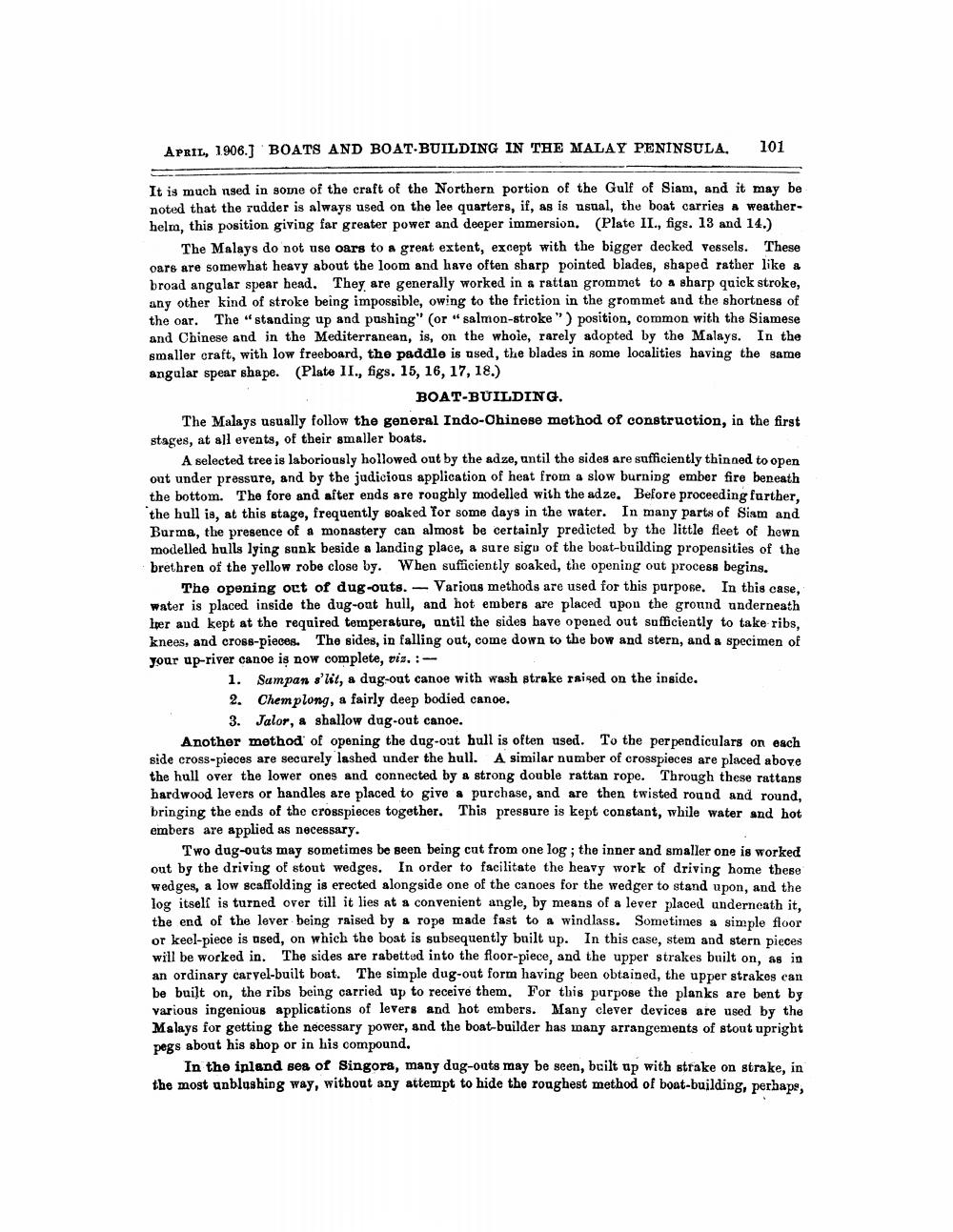________________
APRIL, 1906.] BOATS AND BOAT-BUILDING IN THE MALAY PENINSULA.
It is much used in some of the craft of the Northern portion of the Gulf of Siam, and it may be noted that the rudder is always used on the lee quarters, if, as is usual, the boat carries a weatherhelm, this position giving far greater power and deeper immersion. (Plate II., figs. 13 and 14.)
101
The Malays do not use oars to a great extent, except with the bigger decked vessels. These oars are somewhat heavy about the loom and have often sharp pointed blades, shaped rather like a broad angular spear head. They are generally worked in a rattan grommet to a sharp quick stroke, any other kind of stroke being impossible, owing to the friction in the grommet and the shortness of the oar. The "standing up and pushing" (or "salmon-stroke") position, common with the Siamese and Chinese and in the Mediterranean, is, on the whole, rarely adopted by the Malays. In the smaller craft, with low freeboard, the paddle is used, the blades in some localities having the same angular spear shape. (Plate II., figs. 15, 16, 17, 18.)
BOAT-BUILDING.
The Malays usually follow the general Indo-Chinese method of construction, in the first stages, at all events, of their smaller boats.
A selected tree is laboriously hollowed out by the adze, until the sides are sufficiently thinned to open out under pressure, and by the judicious application of heat from a slow burning ember fire beneath the bottom. The fore and after ends are roughly modelled with the adze. Before proceeding further, the hull is, at this stage, frequently soaked for some days in the water. In many parts of Siam and Burma, the presence of a monastery can almost be certainly predicted by the little fleet of hewn modelled hulls lying sunk beside a landing place, a sure sigu of the boat-building propensities of the brethren of the yellow robe close by. When sufficiently soaked, the opening out process begins.
The opening out of dug-outs. Various methods are used for this purpose. In this case, water is placed inside the dug-out hull, and hot embers are placed upon the ground underneath her and kept at the required temperature, until the sides have opened out sufficiently to take ribs, knees, and cross-pieces. The sides, in falling out, come down to the bow and stern, and a specimen of your up-river canoe is now complete, viz. :
-
1. Sampan s'lit, a dug-out canoe with wash strake raised on the inside. 2. Chemplong, a fairly deep bodied canoe.
3. Jalor, a shallow dug-out canoe.
Another method of opening the dug-out bull is often used. To the perpendiculars on each side cross-pieces are securely lashed under the hull. A similar number of crosspieces are placed above the hull over the lower ones and connected by a strong double rattan rope. Through these rattans hardwood levers or handles are placed to give a purchase, and are then twisted round and round, bringing the ends of the crosspieces together. This pressure is kept constant, while water and hot embers are applied as necessary.
Two dug-outs may sometimes be seen being cut from one log; the inner and smaller one is worked out by the driving of stout wedges. In order to facilitate the heavy work of driving home these wedges, a low scaffolding is erected alongside one of the canoes for the wedger to stand upon, and the log itself is turned over till it lies at a convenient angle, by means of a lever placed underneath it, the end of the lever being raised by a rope made fast to a windlass. Sometimes a simple floor or keel-piece is used, on which the boat is subsequently built up. In this case, stem and stern pieces will be worked in. The sides are rabetted into the floor-piece, and the upper strakes built on, as in an ordinary carvel-built boat. The simple dug-out form having been obtained, the upper strakes can be built on, the ribs being carried up to receive them. For this purpose the planks are bent by various ingenious applications of levers and hot embers. Many clever devices are used by the Malays for getting the necessary power, and the boat-builder has many arrangements of stout upright pegs about his shop or in his compound.
In the inland sea of Singora, many dug-outs may be seen, built up with strake on strake, in the most unblushing way, without any attempt to hide the roughest method of boat-building, perhaps,




